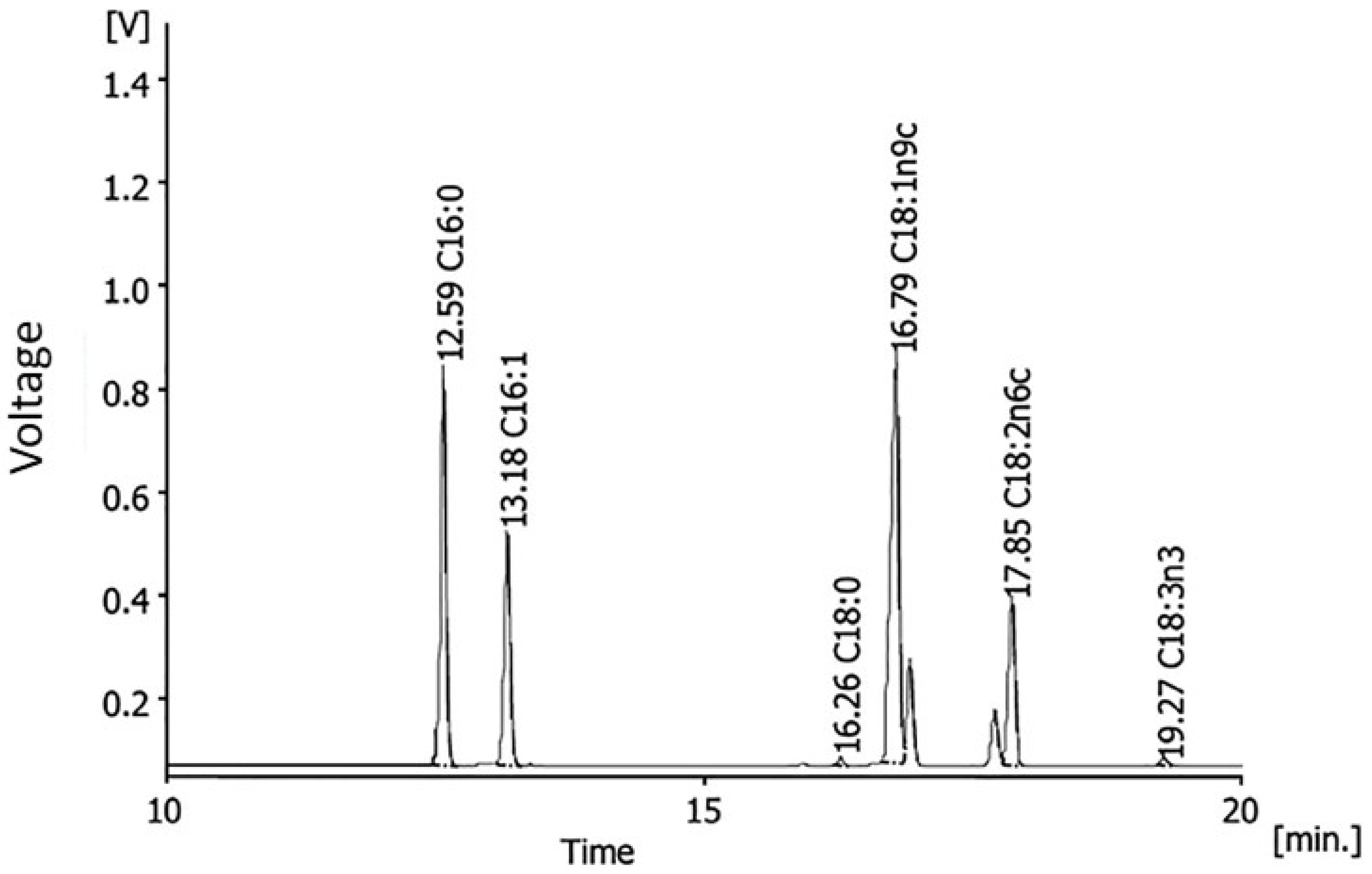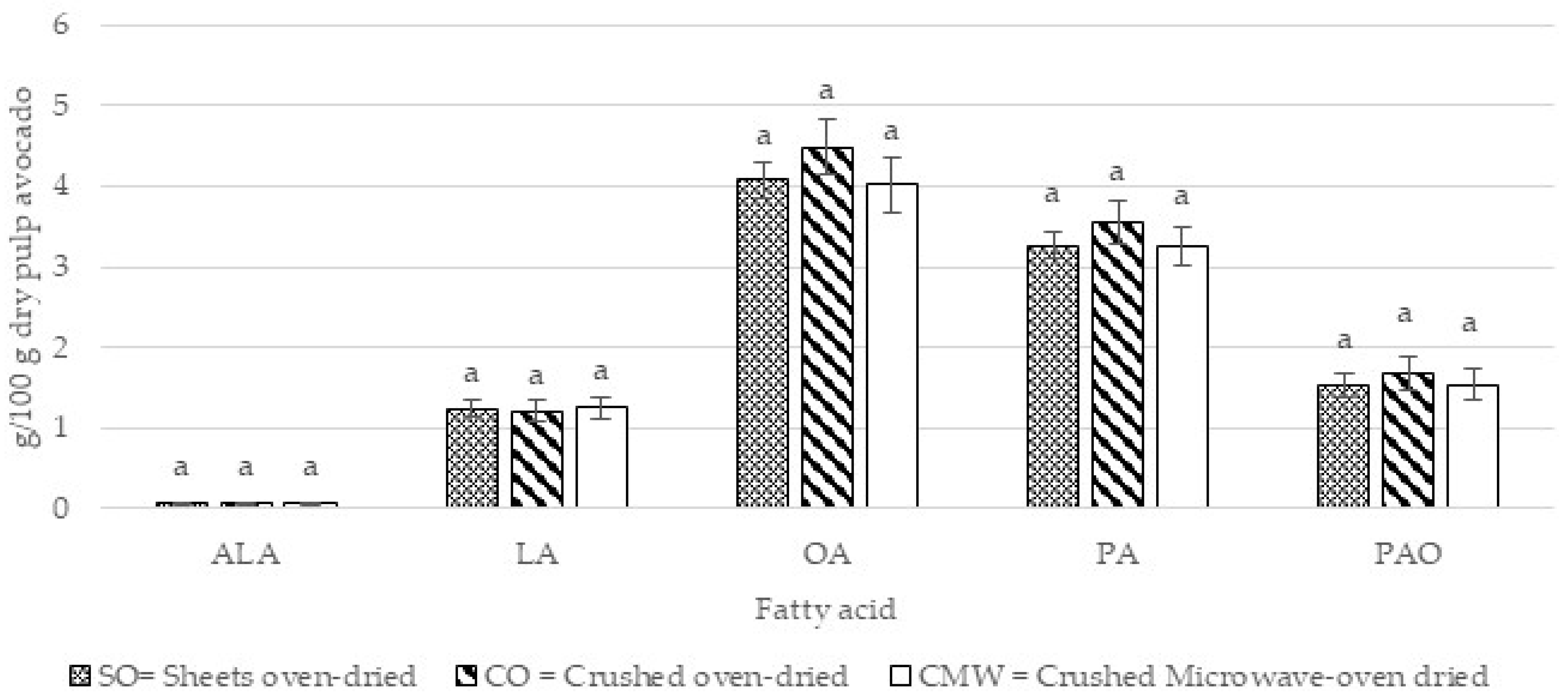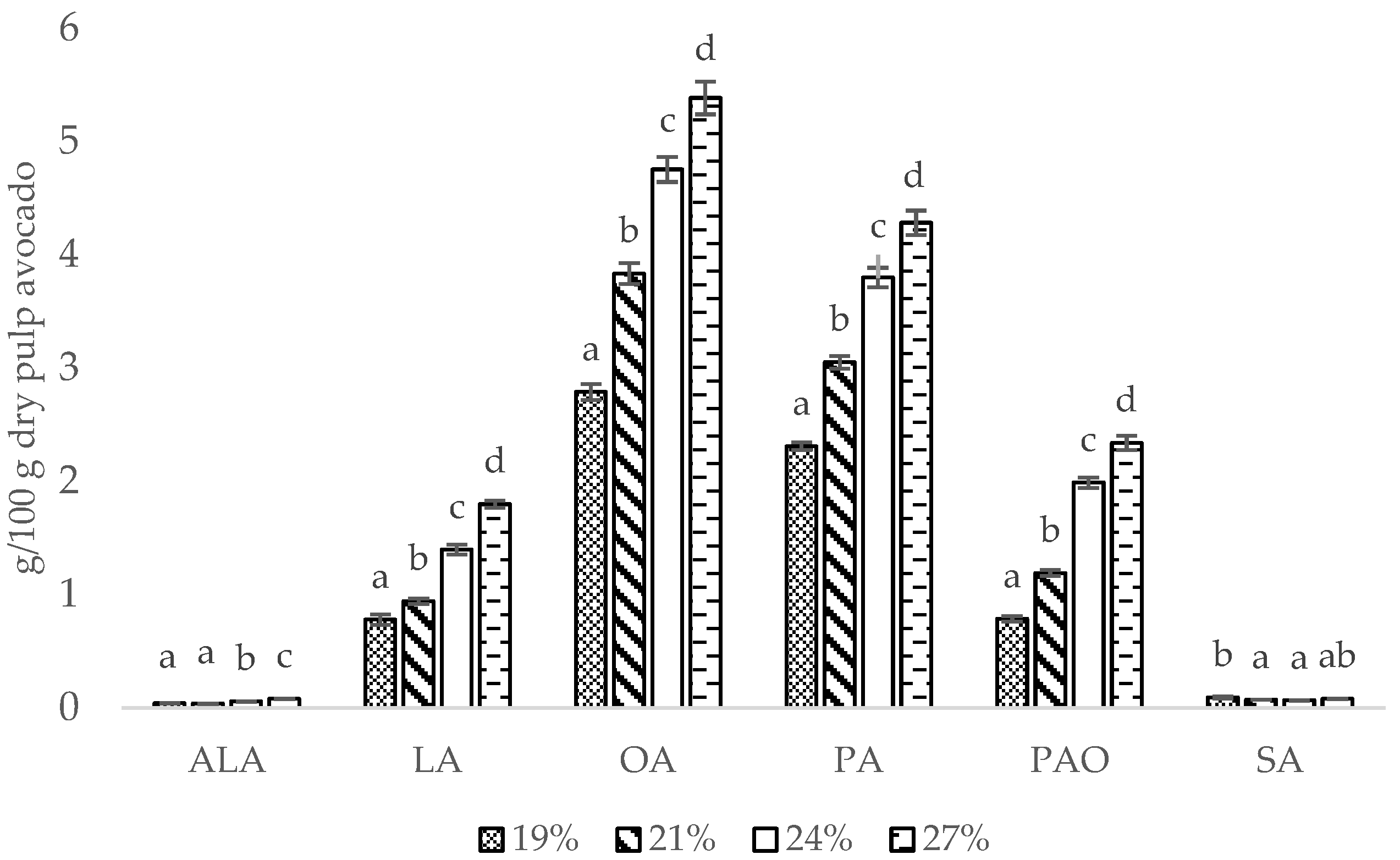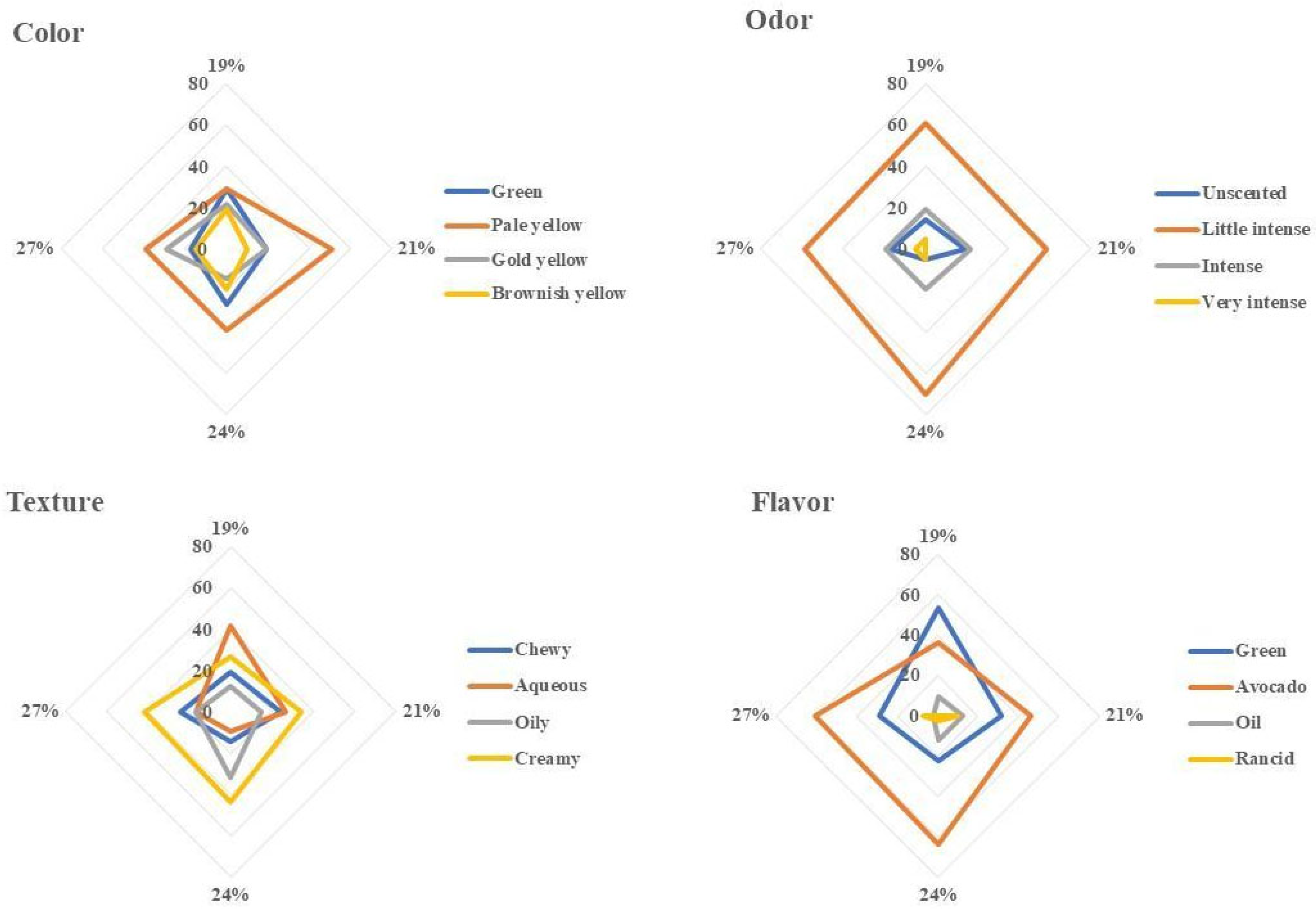‘Hass’ Avocados Cultivated in the Canary Islands: Sensory Attributes Related to Fatty Acid Profiles
Abstract
1. Introduction
2. Materials and Methods
2.1. Harvest of Fruits
2.2. Plant Material Preparation
- Opposite eighths method:
- Equatorial core method:
2.2.1. Dry Matter Determination
Near-Infrared Spectroscopy (NIRS)
Dehydration Methods
- Method A: Here, 2 mm thick slices of avocado pulp were dried at 60 °C in a conventional oven until constant weight was achieved (approximately 72 h) [7].
- Method B: Pulp was homogenized using an electric grinder to produce a uniform mass (approximately 5 min). Six watch glasses were placed in a microwave oven, and time and power cycles were applied according to the protocol of Dorta et al. (2021) [15].
- Method C: The avocado pulp was prepared similarly to method B, but the dehydration was carried out in an oven at 60 °C under the same conditions as method A.
2.3. Oil Extraction and Fatty Acid Analysis
2.4. Fruit Ripening Conditions
2.5. Analysis of Acceptance and Preference
- Color: greenish, pale yellow, golden yellow, brownish yellow;
- Odor: no scent, slightly intense, intense, very intense;
- Texture: chewy, watery, oily, creamy;
- Flavor: green, avocado, oily–fatty, rancid.
2.6. Statistical Analysis
3. Results
3.1. Method of Stabilization of Avocado Pulp cv. ‘Hass’
3.2. Evolution of Fatty Acid Profiles
3.3. Sensory Evaluation
3.4. Generalized Linear Model
4. Discussion
5. Conclusions
Author Contributions
Funding
Data Availability Statement
Conflicts of Interest
Abbreviations
| PGI | Protected Geographical Indication |
| DM | Dry Matter |
| MW | Microwave |
| Pf | Weight of fresh avocado |
| Pd | Weight of dry avocado |
| SO | Sheets oven-dried |
| CO | Crushing oven-dried |
| CMW | Crushing microwave-oven-dried |
| GC-FID | Gas chromatography with flame ionization detection |
| FAME | Fatty acid methyl esters |
| SE | Standard error |
| ANOVA | Analysis of variance |
| HSD | Tukey’s Honestly Significant Difference |
| GLM | Generalized Linear Model |
| OA | Oleic Acid |
| PA | Palmitic Acid |
| POA | Palmitoleic Acid |
| LA | Linoleic Acid |
| SA | Stearic Acid |
| ALA | α-linolenic acid |
| BIC | Bayesian information criterion |
| GOF | Hosmer-Lemeshow Goodness of Fit |
| EFSA | European Food Safety Authority |
| AI | Adequate intake |
| EU | European Union |
| RI | Reference Intake |
| FDA | Food and Drug Administration |
Appendix A
| FATTY ACIDS | F | DF | p-Value |
|---|---|---|---|
| Palmitic acid (PA) | 127,771 | 3 | 0.000 |
| Palmitoleic acid (PAO) | 272,900 | 3 | 0.000 |
| Stearic acid (SA) | 4621 | 3 | 0.009 |
| Oleic acid (PAO) | 34,466 | 3 | 0.000 |
| Linoleic acid (LA) | 152,420 | 3 | 0.000 |
| Alph-linoleic acid (ALA) | 74,682 | 3 | 0.000 |
References
- Bhuyan, D.J.; Alsherbiny, M.A.; Perera, S.; Low, M.; Basu, A.; Devi, O.A.; Barooah, M.S.; Li, C.G.; Papoutsis, K. The Odyssey of Bioactive Compounds in Avocado (Persea americana) and Their Health Benefits. Antioxidants 2019, 8, 426. [Google Scholar] [CrossRef] [PubMed]
- Ford, N.A.; Spagnuolo, P.; Kraft, J.; Bauer, E. Nutritional Composition of Hass Avocado Pulp. Foods 2023, 12, 2516. [Google Scholar] [CrossRef] [PubMed]
- Yahia, E.M.; González-Aguilar, G.A.; Ornelas-Paz, J.d.J.; Luzardo-Ocampo, I. Identification and Characterization of Phytochemicals in Avocado (Persea americana Mill. Var. Hass) Fruit at Different Maturation and Ripening Stages. J. Food Qual. 2025, 2025, 7181926. [Google Scholar] [CrossRef]
- Instituto Canario de Estadística (ISTAC). Available online: https://www3.gobiernodecanarias.org/istac/statistical-visualizer/visualizer/collection.html?resourceType=collection&agencyId=ISTAC&resourceId=E01135A_000001 (accessed on 1 January 2025).
- Decision (EU) 2022/591 of the European Parliament and of the Council of 6 April 2022 on a General Union Environment Action Programme to 2030. Available online: https://eur-lex.europa.eu/eli/dec/2022/591/oj/eng (accessed on 1 January 2025).
- Commission Implementing Regulation (EU) 2025/801 of 14 April 2025 on the Registration of the Geographical Indication ‘Aguacate de Canarias’ (PGI) in the Union Register of Geographical Indications Pursuant to Regulation (EU) 2024/1143 of the European Parliament and of the Council. Available online: https://eur-lex.europa.eu/eli/reg_impl/2025/801/oj (accessed on 3 May 2025).
- Comisión del Codex Alimentarius. Requisitos de Madurez: Métodos de Análisis Para La Determinación Del Contenido de Materia Seca. In Proceedings of the Programa Conjunto FAO/OMS Sobre Normas Alimentarias Comité del CODEX Sobre Frutas y Hortalizas Frescas 16a Reunión, Mexico City, Mexico, 2–6 May 2011; FAO: Rome, Italy, 2012; pp. 1–11. [Google Scholar]
- Arpaia, M.L.; Boreham, D.; Hofshi, R. Development of a New Method for Measuring Minimum Maturity of Avocados; California Avocado Society: Ventura, CA, USA, 2001; Volume 85, pp. 153–178. [Google Scholar]
- Ozdemir, F.; Topuz, A. Changes in Dry Matter, Oil Content and Fatty Acids Composition of Avocado during Harvesting Time and Post-Harvesting Ripening Period. Food Chem. 2004, 86, 79–83. [Google Scholar] [CrossRef]
- Alkaltham, M.S.; Uslu, N.; Özcan, M.M.; Salamatullah, A.M.; Mohamed Ahmed, I.A.; Hayat, K. Effect of Drying Process on Oil, Phenolic Composition and Antioxidant Activity of Avocado (Cv. Hass) Fruits Harvested at Two Different Maturity Stages. LWT 2021, 148, 111716. [Google Scholar] [CrossRef]
- Guzmán-Gerónimo, R.I.; López, M.G.; Dorantes-Álvarez, L. Microwave processing of avocado: Volatile flavor profiling and olfactometry. Innov. Food Sci. Emerg. Technol. 2008, 9, 501–506. [Google Scholar] [CrossRef]
- Burdon, J.; Lallu, N.; Haynes, G.; Francis, K.; Patel, M.; Laurie, T.; Hardy, J. Relationship between Dry Matter and Ripening Time in “Hass” Avocado. Acta Hortic. 2015, 1091, 291–296. [Google Scholar] [CrossRef]
- Hausch, B.J.; Arpaia, M.L.; Campisi Pinto, S.; Obenland, D.M. Sensory characterization of two California grown avo-cado varieties (Persea americana Mill.) over the harvest season by descriptive analysis and consumer tests. Horticulturae 2021, 7, 4134–4147. [Google Scholar] [CrossRef]
- Gamble, J.; Harker, F.R.; Jaeger, S.R.; White, A.; Bava, C.; Beresford, M.; Stubbings, B.; Wohlers, M.; Hofman, P.J.; Marques, R.; et al. The impact of dry matter, ripeness and internal defects on consumer perceptions of avocado quality and intentions to purchase. Postharvest Biol. Technol. 2010, 57, 35–43. [Google Scholar] [CrossRef]
- Dorta, E.; Méndez, C.; Díaz-Delgado, G.; Lobo, M.G. Método Rápido Para La Determinación de Materia Seca En Aguacate; Instituto Canario de Investigaciones Agrarias, ICIA: San Cristóbal de La Laguna, Spain, 2021. [Google Scholar]
- Subedi, P.P.; Walsh, K.B. Assessment of Avocado Fruit Dry Matter Content Using Portable near Infrared Spectroscopy: Method and Instrumentation Optimisation. Postharvest Biol. Technol. 2020, 161, 111078. [Google Scholar] [CrossRef]
- AOAC. Official Methods of Analysis of AOAC International, 18th ed.; AOAC International: Gaithersburg, MD, USA, 2005. [Google Scholar]
- Pinela, J.; Barros, L.; Carvalho, A.M.; Ferreira, I.C.F.R. Influence of the Drying Method in the Antioxidant Potential and Chemical Composition of Four Shrubby Flowering Plants from the Tribe Genisteae (Fabaceae). Food Chem. Toxicol. 2011, 49, 2983–2989. [Google Scholar] [CrossRef] [PubMed]
- Pinela, J.; Barreira, J.C.M.; Barros, L.; Verde, S.C.; Antonio, A.L.; Carvalho, A.M.; Oliveira, M.B.P.P.; Ferreira, I.C.F.R. Suitability of Gamma Irradiation for Preserving Fresh-Cut Watercress Quality during Cold Storage. Food Chem. 2016, 206, 50–58. [Google Scholar] [CrossRef] [PubMed]
- Pereira, C.; Barros, L.; Carvalho, A.M.; Ferreira, I.C.F.R. Nutritional Composition and Bioactive Properties of Commonly Consumed Wild Greens: Potential Sources for New Trends in Modern Diets. Food Res. Int. 2011, 44, 2634–2640. [Google Scholar] [CrossRef]
- Greenfield, H.; Southgate, D.A.T. Food Composition Data Production, Management and Use, 2nd ed.; FAO: Rome, Italy, 2003. [Google Scholar]
- Lim, J. Hedonic Scaling: A Review of Methods and Theory. Food Qual. Prefer. 2011, 22, 733–747. [Google Scholar] [CrossRef]
- ISO 4120:2021; Sensory Analysis—Methodology—Triangle Test. International Organization for Standardization (ISO): Geneva, Switzerland, 2021.
- Magwaza, L.S.; Tesfay, S.Z. A Review of Destructive and Non-Destructive Methods for Determining Avocado Fruit Maturity. Food Bioproc. Technol. 2015, 8, 1995–2011. [Google Scholar] [CrossRef]
- Pisani, C.; Ritenour, M.A.; Stover, E.; Plotto, A.; Alessandro, R.; Kuhn, D.N.; Schnell, R.J. Postharvest and Sensory Evaluation of Selected ‘Hass’ × ‘Bacon’ and ‘Bacon’ × ‘Hass’ Avocado Hybrids Grown in East-Central Florida. HortScience 2017, 52, 880–886. [Google Scholar] [CrossRef]
- De Mendiburu, F.; Muhammad, Y. Agricolae: Statistical Procedures for Agricultural Research. 2020. Available online: https://CRAN.R-project.org/package=agricolae (accessed on 1 May 2025).
- Pandiselvam, R.; Tak, Y.; Olum, E.; Sujayasree, O.J.; Tekgül, Y.; Koç, G.Ç.; Kaur, M.; Nayi, P.; Kothakota, A. Advanced Osmotic Dehydration Techniques Combined with Emerging Drying Methods for Sustainable Food Production: Impact on Bioactive Components, Texture, Color, and Sensory Properties of Food. J. Texture Stud. 2022, 53, 737–762. [Google Scholar] [CrossRef]
- Marović, R.; Badanjak Sabolović, M.; Brnčić, M.; Ninčević Grassino, A.; Kljak, K.; Voća, S.; Karlović, S.; Rimac Brnčić, S. The Nutritional Potential of Avocado By-Products: A Focus on Fatty Acid Content and Drying Processes. Foods 2024, 13, 2003. [Google Scholar] [CrossRef]
- Viera, W.; Gaona, P.; Samaniego, I.; Sotomayor, A.; Viteri, P.; Noboa, M.; Merino, J.; Mejía, P.; Park, C.H. Mineral Content and Phytochemical Composition of Avocado var. Hass Grown Using Sustainable Agriculture Practices in Ecuador. Plants 2023, 12, 1791. [Google Scholar] [CrossRef]
- Rodríguez, P.; Soto, I.; Villamizar, J.; Rebolledo, A. Fatty Acids and Minerals as Markers Useful to Classify Hass Avocado Quality: Ripening Patterns, Internal Disorders, and Sensory Quality. Horticulturae 2023, 9, 460. [Google Scholar] [CrossRef]
- Pedreschi, R.; Hollak, S.; Harkema, H.; Otma, E.; Robledo, P.; Westra, E.; Somhorst, D.; Ferreyra, R.; Defilippi, B.G. Impact of postharvest ripening strategies on ‘Hass’ avocado fatty acid profiles. S. Afr. J. Bot. 2016, 103, 32–35. [Google Scholar] [CrossRef]
- Gonçalves, D.; Gouveia, C.S.S.; Ferreira, M.J.; Ganança, J.F.T.; Pinto, D.C.G.; de Carvalho, M.A.A.P. Comparative Analysis of Antioxidant and Fatty Acid Composition in Avocado (Persea americana Mill.) Fruits: Exploring Regional and Commercial Varieties. Food Chem. 2024, 442, 138403. [Google Scholar] [CrossRef] [PubMed]
- Méndez Hernández, C.; Ríos Mesa, D.; Rodríguez-Galdón, B.; Rodríguez-Rodríguez, E.M. Study of Environmental Factors on the Fat Profile of Hass Avocados. J. Food Compos. Anal. 2023, 123, 105544. [Google Scholar] [CrossRef]
- Sakouhi, F.; Absalon, C.; Kallel, H.; Boukhchina, S. Comparative analysis of triacylglycerols from Olea europaea L. fruits using HPLC and MALDI-TOFMS. Eur. J. Lipid Sci. Technol. 2010, 112, 574–579. [Google Scholar] [CrossRef]
- Villa-Rodríguez, J.A.; Molina-Corral, F.J.; Ayala-Zavala, J.F.; Olivas, G.I.; González-Aguilar, G.A. Effect of maturity stage on the content of fatty acids and antioxidant activity of ‘Hass’ avocado. Food Res. Int. 2011, 44, 1231–1237. [Google Scholar] [CrossRef]
- Berasategi, I.; Barriuso, B.; Ansorena, D.; Astiasarán, I. Stability of avocado oil during heating: Comparative study to olive oil. Food Chem. 2012, 132, 439–446. [Google Scholar] [CrossRef]
- Pardo, J.E.; Rabadán, A.; Suárez, M.; Tello, J.; Zied, D.C.; Álvarez-Ortí, M. Influence of Olive Maturity and Season on the Quality of Virgin Olive Oils from the Area Assigned to the Protected Designation of Origin of “Aceite de la Alcarria” (Spain). Agronomy 2021, 11, 1439. [Google Scholar] [CrossRef]
- Farina, V.; Reig, C. Fatty acids and sugar composition of avocado fruit during harvesting time and post-harvest ripening period: A review. Italus Hortus 2018, 25, 1–11. [Google Scholar] [CrossRef]
- Siri-Tarino, P.W.; Sun, Q.; Hu, F.B.; Krauss, R.M. Saturated fatty acids and risk of coronary heart disease: Modulation by replacement nutrients. Curr. Atheroscler. Rep. 2010, 12, 384–390. [Google Scholar] [CrossRef]
- Dreher, M.L.; Davenport, A.J. Hass avocado composition and potential health effects. Crit. Rev. Food Sci. Nutr. 2013, 53, 738–750. [Google Scholar] [CrossRef]
- Marín-Obispo, L.M.; Villarreal-Lara, R.; Rodríguez-Sánchez, D.G.; Del Follo-Martínez, A.; de la Cruz Espíndola Barquera, M.; la Garza, J.S.J.-D.; de la Garza, R.I.D.; Hernández-Brenes, C. Insights into Drivers of Liking for Avocado Pulp (Persea americana): Integration of Descriptive Variables and Predictive Modeling. Foods 2021, 10, 99. [Google Scholar] [CrossRef]
- EFSA. Dietary Reference Values for Nutrients Summary Report; American Chemical Society: Washington, DC, USA, 2017. [Google Scholar]
- FDA. Nutrition Facts for Raw Fruits. 2008; Volume 51. Available online: https://www.fda.gov/food/food-labeling-nutrition/nutrition-information-raw-fruits-vegetables-and-fish (accessed on 1 May 2025).




| Dry Matter (%DM). | 19 | 21 | 24 | 27 | p-Value |
|---|---|---|---|---|---|
| Color | 6 (4–7)a | 6 (5–7) ab | 6 (6–8) bc | 7 (6–8) c | 0.001 |
| Odor | 5 (4–7)a | 6 (5–7) a | 6 (5–7) a | 6 (5–7) a | 0.819 |
| Texture | 5 (3–6)a | 5 (4–7) ab | 6 (5–7) b | 6 (5–8) b | 0.001 |
| Flavor | 5 (3–6)a | 6 (4–7) ab | 7 (6–8) b | 7 (5–8) b | 0.000 |
| Fatty Acids | Countries Producing Avocados | ||||
|---|---|---|---|---|---|
| Ecuador | Mexico | Colombia | Chile | Portugal | |
| PA (16:0) | 18.45–20.04 | 12.08–17.01 | 17.34–26.13 | 13.2–14.1 | 8.52–9.09 |
| PAO (16:1) | 8.63–9.21 | 6.13–10.73 | 7.04–12.01 | 3.4–3.5 | |
| SA (18:0) | 0.49–0.56 | 0.24–0.40 | 0.60–0.87 | ||
| OA (18:1) | 50.20–51.24 | 70.13–78.31 | 44.88–64.16 | 66.4–67.6 | 42.05–43.47 |
| LA (18:2n6) | 11.83–12.45 | 2.22–3.53 | 9.18–14.37 | 14.7–14.9 | 41.76–61.93 |
| ALA (18:3n3) | 0.83–0.95 | 0.11–0.27 | 0.71–1.04 | 1.1 | |
| Other | 7.14–7.53 | 0.04–0.07 | 0.29–0.37 | 7.10–10.23 | |
Disclaimer/Publisher’s Note: The statements, opinions and data contained in all publications are solely those of the individual author(s) and contributor(s) and not of MDPI and/or the editor(s). MDPI and/or the editor(s) disclaim responsibility for any injury to people or property resulting from any ideas, methods, instructions or products referred to in the content. |
© 2025 by the authors. Licensee MDPI, Basel, Switzerland. This article is an open access article distributed under the terms and conditions of the Creative Commons Attribution (CC BY) license (https://creativecommons.org/licenses/by/4.0/).
Share and Cite
Dorta, E.; Alonso-Esteban, J.I.; Álvarez-Acosta, C.; Lobo, M.G. ‘Hass’ Avocados Cultivated in the Canary Islands: Sensory Attributes Related to Fatty Acid Profiles. Horticulturae 2025, 11, 763. https://doi.org/10.3390/horticulturae11070763
Dorta E, Alonso-Esteban JI, Álvarez-Acosta C, Lobo MG. ‘Hass’ Avocados Cultivated in the Canary Islands: Sensory Attributes Related to Fatty Acid Profiles. Horticulturae. 2025; 11(7):763. https://doi.org/10.3390/horticulturae11070763
Chicago/Turabian StyleDorta, Eva, José Ignacio Alonso-Esteban, Carlos Álvarez-Acosta, and M. Gloria Lobo. 2025. "‘Hass’ Avocados Cultivated in the Canary Islands: Sensory Attributes Related to Fatty Acid Profiles" Horticulturae 11, no. 7: 763. https://doi.org/10.3390/horticulturae11070763
APA StyleDorta, E., Alonso-Esteban, J. I., Álvarez-Acosta, C., & Lobo, M. G. (2025). ‘Hass’ Avocados Cultivated in the Canary Islands: Sensory Attributes Related to Fatty Acid Profiles. Horticulturae, 11(7), 763. https://doi.org/10.3390/horticulturae11070763







